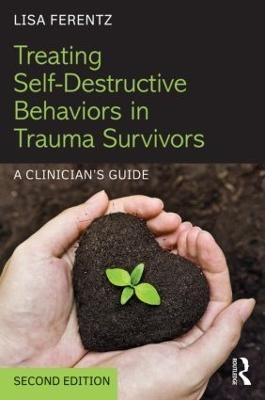
Treating Self-Destructive Behaviors in Trauma Survivors
Routledge (Verlag)
978-1-138-80075-5 (ISBN)
Treating Self-Destructive Behaviors in Trauma Survivors, 2nd ed, is a book for clinicians who specialize in helping trauma survivors and, during the course of treatment, find themselves unexpectedly confronted with client disclosures of self-destructive behaviors, including self-mutilation and other manifestations of deliberately "hurting the body" such as bingeing, purging, starving, substance abuse and other addictive behaviors. Arguing that standard safety contracts are not effective, renowned clinician Lisa Ferentz introduces viable treatment alternatives, assessment tools, and new ways of understanding self-destructive behavior using a strengths-based approach that distinguishes between the "experimental" non-suicidal self-injury (NSSI) that some teenagers occasionally engage in and the self-destructive behaviors that are repetitive and chronic. In the new edition, many of the treatment strategies are cross referenced to a useful workbook, giving therapists and clients concrete ways to integrate theory into practice. In addition, Ferentz emphasizes the importance of assessing for and strengthening clients' self-compassion, and explains how nurturing this idea cognitively, emotionally, and somatically can become the catalyst for motivation and change. The book also explores a cycle of behavior that clinicians can personalize and use as a template for treatment. In its final sections, the book focuses on counter-transferential responses and the different ways in which therapists can work with self-destructive behaviors and avoid vicarious traumatization by adopting tools and strategies for self-care.
Treating Self-Destructive Behaviors in Trauma Survivors, 2nd ed, can be used on its own or in conjunction with the accompanying client-focused workbook, Letting Go of Self-Destructive Behaviors: A Workbook of Hope and Healing.
Lisa Ferentz, LCSW-C, is the president and founder of the Institute for Advanced Psychotherapy Training and Education, which provides continuing education to mental health professionals. She is an internationally acclaimed speaker and highly sought after clinical consultant. She has been in solo private practice specializing in trauma for more than thirty years, and in 2009 was named social worker of the year by the Maryland Society for Clinical Social Work.
Preface Part I: It Makes Sense Given Where They’ve Come From. 1. Toward a New Understanding of Self-Destructive Behaviors. 2. Working With Trauma Survivors. 3. The Role of Attachment. 4. The Inherent Struggles of Adolescence. 5. The Metacommunication of Eating Disorders, Addictions, and Self-Mutilation. Part II: Understanding and Working With Self-Destructive Behaviors. 6. The Cycle of Self-Destructive Behaviors. 7. The Triggering Event and the Loop of Negativity. 8. Unbearable Anxiety and the Frozen Loop. 9. Self-Destructive Behaviors, Positive Outcomes, Negative Outcomes, and Emotional Vulnerability. 10. Treatment. 11. Working With the Cycle: The Loop of Negativity. 12. Working With the Cycle: Unbearable Anxiety and the Frozen Loop. 13. Working With the Cycle: Self-Destructive Behaviors and CARESS. 14. Working With the Cycle: Positive Outcomes, Negative Outcomes, and Emotional Vulnerability. Part III: Helping Others While Taking Care of Ourselves. 15. Focusing on Us. 16. Creating a Sense of Internal and External Safety. 17. Assessing Your Agenda. 18. Being Clear About Your Control Issues. 19. Holding Appropriate Boundaries. 20. Understanding Your Triggers. 21. Acknowledging Your Vulnerabilities. 22. Pacing the Sessions. 23. Debriefing After Difficult Sessions. 24. Understanding the Correlation Between Family-of-Origin and Workplace Dynamics. 25. Striving for Balance in Your Life. 26. Giving Yourself Permission to Get Supervision or Refer Out. 27. Practicing What You Preach. 28. Strengthening Your Work. Bibliography
| Erscheint lt. Verlag | 8.9.2014 |
|---|---|
| Zusatzinfo | 1 Illustrations, black and white |
| Verlagsort | London |
| Sprache | englisch |
| Maße | 152 x 229 mm |
| Gewicht | 406 g |
| Themenwelt | Geisteswissenschaften ► Psychologie ► Persönlichkeitsstörungen |
| Geisteswissenschaften ► Psychologie ► Traumatherapie | |
| Medizin / Pharmazie ► Medizinische Fachgebiete ► Notfallmedizin | |
| Medizin / Pharmazie ► Medizinische Fachgebiete ► Psychiatrie / Psychotherapie | |
| Sozialwissenschaften ► Soziologie | |
| ISBN-10 | 1-138-80075-9 / 1138800759 |
| ISBN-13 | 978-1-138-80075-5 / 9781138800755 |
| Zustand | Neuware |
| Informationen gemäß Produktsicherheitsverordnung (GPSR) | |
| Haben Sie eine Frage zum Produkt? |
aus dem Bereich


